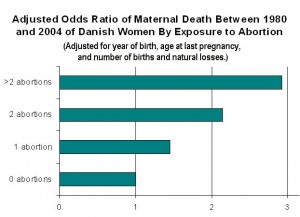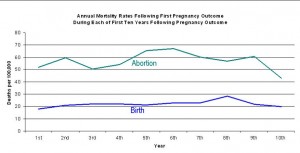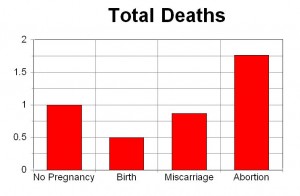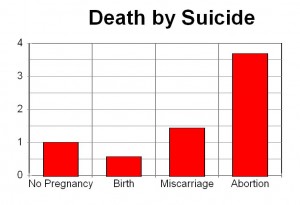Abortions Increase Risk of Maternal Death: New Study
Springfield, IL (September 7, 2012) — A single induced abortion increases the risk of maternal death by 45 percent compared to women with no history of abortion, according to a new study of all women of reproductive age in Denmark over a 25 year period.

In addition, each additional abortion is associated with an even higher death rate. (Figure 1) Women who had two abortions were 114 percent more likely to die during the period examined, and women had three or more abortions had a 192 percent increased risk of death.
Elevated rates of death were also observed among women who experienced miscarriages, ectopic pregnancies or other natural losses.
Women with a history of successful deliveries were the least likely to die during the 25 years examined. Women who had never been pregnant had the highest mortality rate.

Among women with a history of multiple pregnancies, women with a history of both abortions and natural losses, but no live births, had the highest mortality rate. (Figure 2)
The study is the second record linkage analysis of Danish mortality data to be published this month.
The earlier study was limited to comparing mortality rates following only the first pregnancy outcome. It found that abortion of a first pregnancy was associated with a higher rate of death compared to death rates among women who delivered a first pregnancy. The higher death rate among women who had abortions persisted for each of the first ten years following the first pregnancy outcome. (Figure 3)

“Dose Effect” Supports Causal Link
The finding that each additional abortion or other pregnancy loss contributed to a rising death rate is an indication that the observed effects are more likely to be causal than incidental, according to Dr. David Reardon, one of the co-authors of both studies.
“We knew from our previous studies of low income women in California that women who have multiple pregnancy outcomes, such as having a history of both abortion and miscarriage, have significantly different mortality rates,” Reardon said. “But this new study is the first to examine how each experience with abortion or miscarriage contributes to higher mortality rates.”
This is called a “dose effect” because “each exposure, or ‘dose,’ is seen to produce more of the same effect, which is what one would expect if there is a cause-effect relationship,” Reardon explained.
Reardon is the director of the Elliot Institute, which funds research related to abortion. He believes further research is needed to explore how the outcomes observed in this latest study may be influenced by abortion’s impact on natural pregnancy losses. A new population study from Finland, for example, has found that abortion is associated with higher rates of preterm delivery, low birth weight delivery, and perinatal deaths in subsequent pregnancies.
Reardon believes that a truer picture of the benefits of childbirth and the risks of abortion and pregnancy loss is now emerging because of a shift to more reliable record linkage studies. Such studies have been conducted in Finland, Denmark and the United States.
Findings Similar to Those in Finland

A 1997 government funded record linkage study in Finland found that women who abort are approximately four times more likely to die in the following year compared to women who carry their pregnancies to term. In addition, women who carry to term are only half as likely to die as women who were not pregnant.16 (Figure 4. Click here for more details on this important study.)


The Finland researchers also found that compared to women who carried to term, women who aborted in the year prior to their deaths were 60 percent more likely to die of natural causes (Figure 5), nearly seven times more likely to die of suicide (Figure 6), four times more likely to die of injuries related to accidents, and 14 times more likely to die from homicide.
Researchers believe the higher rate of deaths related to accidents and homicide may be linked to higher rates of suicidal or risk-taking behavior.16 (Click here for details on the latest research regarding abortion associated deaths.)
The leading causes of abortion related maternal deaths within a week of the surgery are hemorrhage, infection, embolism, anesthesia, and undiagnosed ectopic pregnancies. Legal abortion is reported as the fifth leading cause of maternal death in the United States, though in fact it is recognized that most abortion-related deaths are not officially reported as such.2 (Click here for more details on the underreporting of abortion related deaths in the U.S.)
Record Linkage Studies vs. Junk Science
Finland’s National Research and Development Center for Welfare has also shown that without record linkage, that 94 percent of deaths associated with abortion (in the first year alone) are being missed in national data reports on abortion.
This finding most likely applies to every country, including the United States where there is no formal mechanism for reporting abortion related deaths. Indeed, the rules regarding completion of death certificates specifically exclude identifying abortion as a cause of death.
As a result of these institutional barriers, the “official” count of abortion associated deaths reported by the CDC is based purely on ad hoc reports the CDC accepts from public sources. This is why CDC officials have admitted that maternal mortality rates and abortion mortality rates “are conceptually different and are used by the CDC for different public health purposes.”
Despite these warnings by the CDC , abortion advocates continue to compare the incomplete abortion death numbers published the CDC with the incomplete maternal mortality rate. Most recently this was done in a highly publicized medical journal article which concluded, based on what Reardon describes as a “junk in, junk out analyses,” that abortion is 14 times safer than childbirth.
The most damning evidence of the authors’ dishonesty, Reardon says, is that the authors were fully aware of the record linkage studies from Finland and California, having cited the Finland studies and having been given copies of the California study, but these record linkage studies were deliberately excluded from the authors’ literature review and their discussion of the issue.
“Record linkage studies are the only way to use the same objective yard stick for comparing mortality rates associated with pregnancy outcomes,” Reardon said. “More researchers and more research dollars should be expended on investigating these issues. Without it, population control efforts in developing countries may lead to ill-informed public health initiatives which will actually increase death rates among women rather than reduce them.”
Related Articles
- Deaths Associated With Abortion Compared to Childbirth: A Review of New and Old Data and the Medical and Legal Implications.
- Death Rate of Abortion Three Times Higher than Childbirth
- Abortion Has No Benefits, But Does Have Risks, New Research Shows
- CDC Abortion Mortality Reports Flawed: New Study and Head of CDC’s Admission
- The Cover-Up: Why U.S. Abortion Mortality Statistics Are Meaningless
- Rehash of Abortion Safety Claim Ignores All Inconvenient Evidence to the Contrary
- CDC Reports of Abortion Deaths Double: Research Shows Many Deaths Go Uncounted
- Abortion Kills More Women Than Abortion Advocates Admit
- Abortion Four Times Deadlier Than Childbirth
- Illegal Abortions: The Myth and the Cure
Studies Referenced
Coleman PK, Reardon DC, Calhoun BC. Reproductive history patterns and long-term mortality rates: a Danish, population-based record linkage study Eur J Public Health, first published online September 5, 2012
Reardon DC, Coleman PK. Short and long term mortality rates associated with first pregnancy outcome: Population register based study for Denmark 1980-2004. Med Sci Monit 2012;18(9):PH 71 – 76.
Klemetti R, Gissler M, Niinimäki M, Hemminki E. Birth outcomes after induced abortion: a nationwide register-based study of first births in Finland. Hum Reprod 2012 Aug 29. [Epub ahead of print]



God gave us the fifth commandment: “Thou shalt not kill.” Period! We have no power over
God, when we die our souls are in judgement at that moment. There is only 3 places we
can go, Heaven, purgatory or hell. We have no control over God’s judgement at that
moment. There are other means to protect the child in the womb, have the child born and
give the child love or give the child up for adoption. There are plenty of people out there
that would adopt a child. I know because My wife and I adopted a boy, who is loved by all.
So is abortion always bad?
From a research perspective, there have been no studies showing any statistically significant benefits for women who have abortions compared to women who give birth to unplanned pregnancies, but plenty of studies showing that abortion is connected to increased mental health problems. The authors of one study led by a pro-choice researcher wrote:
“In general, there is no evidence in the literature on abortion and mental health that suggests that abortion reduces the mental health risks of unwanted or mistimed pregnancy. Although some studies have concluded that abortion has neutral effects on mental health, no study has reported that exposure to abortion reduces mental health risks.”
https://afterabortion.org/2008/abortion-provides-no-mental-health-benefits-even-when-pregnancy-is-unwanted/
Thank you for this report on the under or non-reporting of abortion deaths. One factor I noted was not included in this study is the higher incidence of placenta acreta, placenta encreta, & placenta percreta among all women having had abortions (as wekk as Cesareans & D & C’s). The scar tissue on the uterus causes the placenta in a new pregnancy to abnormally attach to the uterine wall if the placenta forms over the scar. Research on this problem is found in studies dealing with the sequelae of the extremely high Cesarean rate in the US, currently about 35%. Just thinking logically informs me that more abortions lead to more scar tissue which then leads to more placental issues which can be very life threatening. Thank you.